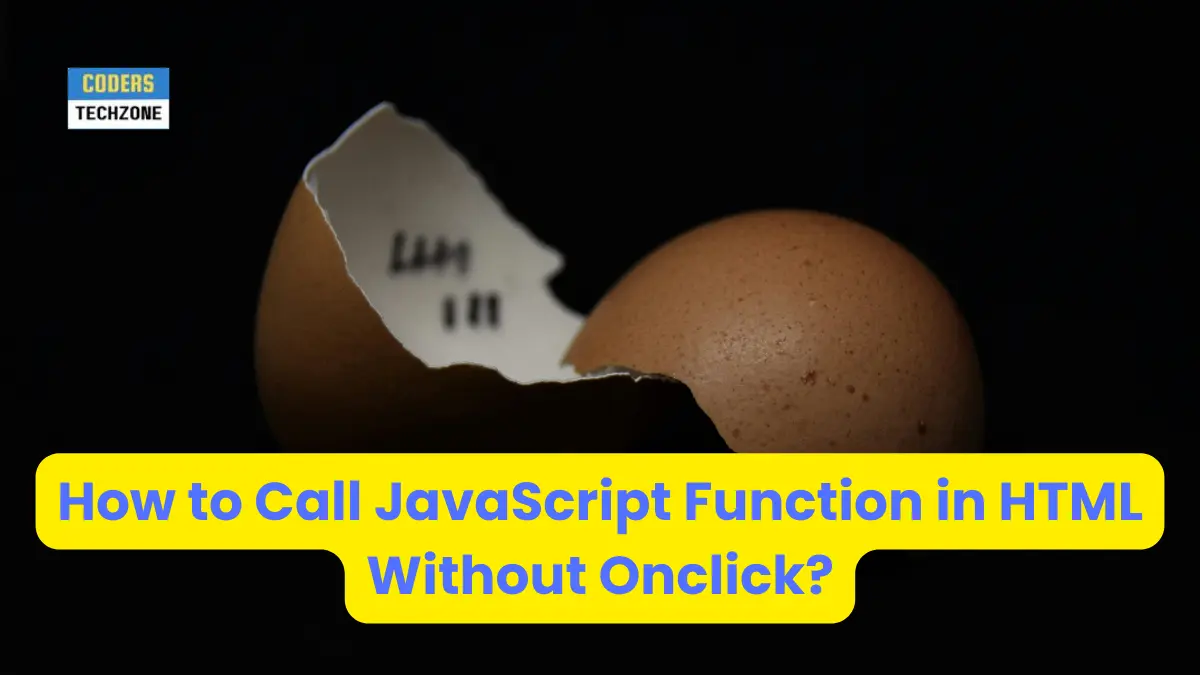How to call JavaScript function in HTML without onclick? Though the most straightforward way is to use the onclick attribute, sometimes there are situations where we have to call a function without onclick.
The best way to call a JavaScript function in HTML without onclick is to use an event listener. It is a modern method of handling JavaScript events and help us to prevent tight coupling between HTML elements and JavaScript methods.
Here, In this article, we are going to share how to call JavaScript function in HTML without onclick by providing different methods, alternative ideas, code examples, and best practices. So bear with us and read to the end.
Table of Contents
Why Should We Avoid Onclick?
While onclick is simple and effective and is used by developers in most cases, there are situations where we have to avoid it. Here are the major cases:
- Separation of Concerns: Keeping HTML and JavaScript separate for better code organization.
- Reusability: Making functions reusable across different elements.
- Readability: Enhancing code readability and maintainability.
5 Proven Methods to Call JavaScript Functions Without Onclick
1. Using Event Listeners
Today, event listeners are the most standard way to handle events in JavaScript. They allow us to attach a function to an element without using inline event attributes like onclick.
<!DOCTYPE html>
<html lang="en">
<head>
<meta charset="UTF-8">
<meta name="viewport" content="width=device-width, initial-scale=1.0">
<title>How to call JavaScript function in HTML without onclick?</title>
</head>
<body>
<button id="myButton">Click Me</button>
<script>
function myFunc() {
console.log("Button clicked! On: "+ new Date().toLocaleString("en-US"));
}
// Add click event listener
document.getElementById('myButton').addEventListener('click', myFunc);
</script>
</body>
</html>output – How to call javascript function in html without onclick using addEventListener
You can also use an anonymous or inline JS function instead of a named function myFunc() like:
<script>
document.getElementById('myButton').addEventListener('click', function() {
console.log('Button clicked!');
});
</script>2. Using the onload Event
The onload event fires when the whole page is loaded. This can be used to automatically call a JavaScript function after the page loads without depending on user actions.
<!DOCTYPE html>
<html lang="en">
<head>
<meta charset="UTF-8">
<meta name="viewport" content="width=device-width, initial-scale=1.0">
<title>Call Function Without Onclick</title>
</head>
<body onload="pageLoaded()">
<h1>Welcome to My Website coderstechzone.com</h1>
<script>
function pageLoaded() {
console.log('Page fully loaded');
}
</script>
</body>
</html>output

3. Using CSS Pseudo-Classes
You can combine CSS pseudo-classes with JavaScript to call a function based on user interactions, like hovering over an element. In this example, we use CSS along with the mouseover addEventListener. Here is the example code:
4. Using setTimeout and setInterval
You can call functions after a specified time interval or repeatedly at fixed intervals using the setTimeout and setInterval method respectively.
Here is an example with setTimeout:
<!DOCTYPE html>
<html lang="en">
<head>
<meta charset="UTF-8">
<meta name="viewport" content="width=device-width, initial-scale=1.0">
<title>JS Call Function Without Onclick</title>
</head>
<body>
<h1>Automatic Message</h1>
<script>
function showMessage() {
console.log('This message appears in 2 seconds!');
}
// Making a 2 seconds delay
setTimeout(showMessage, 2000);
</script>
</body>
</html>Output

Example with setInterval
<!DOCTYPE html>
<html lang="en">
<head>
<meta charset="UTF-8">
<meta name="viewport" content="width=device-width, initial-scale=1.0">
<title>Call Function Without Onclick</title>
</head>
<body>
<h1>Repeated Message</h1>
<script>
function showRepeatedMessage() {
console.log('This message appears every 3 seconds! '+new Date().toLocaleString("en-us"));
}
// For 5 seconds change to 5000
setInterval(showRepeatedMessage, 3000);
</script>
</body>
</html>output
5. Using MutationObserver
MutationObserver is a powerful feature that allows you to monitor changes in the DOM and trigger functions automatically. You can target a node and execute your required code if any changes occur in the target node.
<!DOCTYPE html>
<html lang="en">
<head>
<meta charset="UTF-8">
<meta name="viewport" content="width=device-width, initial-scale=1.0">
<title>Call Function Without Onclick</title>
</head>
<body>
<div id="myDiv">Watch me change</div>
<button onclick="changeContent()">Change Content</button>
<button onclick="changeColor()">Change Color</button>
<script>
function changeContent() {
document.getElementById('myDiv').innerText = 'Content changed!';
}
function changeColor() {
document.getElementById('myDiv').style.color = 'red';
}
// The HTML element that will be observed for mutations
const targetNode = document.getElementById('myDiv');
// Options for the observer - which mutation needs to check
const config = { attributes: true, childList: true, subtree: true };
// Callback function will execute once mutations are observed
const callback = function(mutationsList, observer) {
for(let mutation of mutationsList) {
if (mutation.type === 'childList') {
console.log('Content changed!');
}
else if(mutation.type === 'attributes'){
console.log('Content attribute changed!');
}
}
};
// Create observer instance to a callback function
const observer = new MutationObserver(callback);
// Start observing the target for change
observer.observe(targetNode, config);
</script>
</body>
</html>output
In this example, we target a div. Configure three types of mutations to be detected. If content or font color changes are detected, then a callback function will automatically be invoked. Check the change type and run the code accordingly.
Summary Table of 5 Different Methods
| Method | Description | Use Case |
|---|---|---|
| Event Listeners | Attach functions to events without inline attributes | Handling user interactions |
| Onload Event | Call functions when the page fully loads | Initializing scripts after page load |
| CSS Pseudo-Classes | Combine CSS and JavaScript for dynamic interactions | Visual effects based on user actions |
| setTimeout/setInterval | Schedule functions to execute after a delay or repeatedly | Timed actions or animations |
| MutationObserver | Monitor and react to DOM changes | Dynamic content updates |
Conclusion
Knowing how to call JavaScript function in HTML without onclick is an uncommon skill, and not all JS developers are interested about it at all.
So by using event listeners, the onload event, CSS pseudo-classes, setTimeout, setInterval, and MutationObserver – we are able to create dynamic, organized, and maintainable code without difficulty.
These methods assist us hold our HTML and JavaScript code separate, making the code cleaner and more efficient. Implement those techniques for your tasks to improve capability and the user experience. Happy Coding !!
🏋️♂️ Discover Code Blocks From 20+ yrs JS Expert
💥 Asp.net C# Developer
🏆 Solution Architect
👨✈️ Database Administrator
📢 Speaker
🎓 MCTS since 2009








Leave a Reply